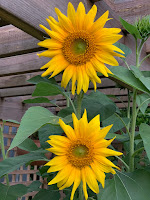A and I are spending a good deal of time outdoors, now that (a) our weekly trips to Brisbane and Maroochydore for aphasia therapies have concluded and (b) an unseasonal spell of (relatively) cold weather appears to have passed. Even A has got into some gardening – albeit in a gentle manner. He had just finished raking all the dead leaves that fell onto this little path from an overhanging tulip tree, when he sat down to enjoy the last of the afternoon sun.
Anyone who's not from these here parts mightn't recognise the basketball-size fruit in this photo. These don't normally fall from the tree whole, like this one we cut down. Just as well, because this particular example weights 3.5 kilograms (that's just under 8 pounds). Left alone, the fruit ripens further, until it splits open while still on the tree. Then the individual segments that make up the fruit drop to the ground, one by one. This probably gives the large seeds contained in the segments a better chance of rolling away from the tree and finding a spot in which to germinate. Even so, with each fruit containing several dozen segments, and 20 or so fruit on even a small tree, that's a lot of fist-sized kernels to pick up (or trip over). Aborigines had a way of using these fruits as food, but I haven't tried them yet. They also used the long, tough, strappy leaves for all manner of woven goods (mats, baskets etc.) The tree's name? Pandanus.
My garden has about six pandanus trees in various sizes, including this large one that overhangs the pool pump house. Thankfully, I haven't yet noticed on my trees any sign of the dieback that is killing a lot of pandanus growing in areas like ours, where the cause of the disease – a North Queensland insect called the planthopper – doesn't have any natural predators.
In another part of the garden, an annual display I always look forward to is again thrilling us every afternoon, when the sun's last rays shine through the nearly transparent and spectacularly red 'bracts' (or leaves) that surround the otherwise insignificant flowers of the poinsettias. I especially love this somewhat neglected, and admittedly straggly, specimen halfway down the paddock.
 Every time the flowers are finished, I debate whether or not to prune the 2 metre stems of the above plant back to some sensible size, as the gardening experts always recommend. I do that to the poinsettias growing in other parts of the garden, including some I keep in containers for a Christmas display and a few others, like this pink variety near the back verandah.
Every time the flowers are finished, I debate whether or not to prune the 2 metre stems of the above plant back to some sensible size, as the gardening experts always recommend. I do that to the poinsettias growing in other parts of the garden, including some I keep in containers for a Christmas display and a few others, like this pink variety near the back verandah. Most poinsettia bracts radiate around their little central flowers on a flat plane. But on some parts of my renegade plant – or maybe there are several plants growing closely together, because these flowers only appear on one side of the big tree – the bracts, like the stems, have gone a bit wild. The result is an almost dahlia-like bloom – yet another reason this poinsettia deserves to be allowed to ramble as and where it chooses. My garden has room enough for a few rebels.







4 comments:
Saw a cooking show last night where in Kuala Lumpur they were using pandanus leaves to line a huge rice steamer. Maybe a use for them? Nan
First glance I thought A was ready to pour himslef a cuppa from a cunningly designed Pandanus look-alike cosie-covered tea pot! Don't tell Loani.
A looks so much brighter!
PS Thanks for the support!
Well, I found you..and I see stafford ray is one of your readers..he's so cute..
Thank you for commenting on my garden blog...I think this will be the beginning of a good relationship....love your plot of earth!...bless you and yours
and by the way..your photos are wonderful...and boy can you write
Welcome to Doonan, Suz. Hope you'll call in again. Then when it's winter at your place, you can at least enjoy some summery scenes at my place.
Post a Comment